PDF chapter test TRY NOW
"Dust of Snow" is a poem written by Robert Frost. It is was first published in \(1923\) in his collection of poems called New Hampshire.
The first stanza of the poem, "Dust of Snow", introduces the only two living characters: the speaker and the crow. The poem, narrated in the first-person point of view, describes a small incident in the speaker's life. The incident might seem trivial; however, it is hardly insignificant.
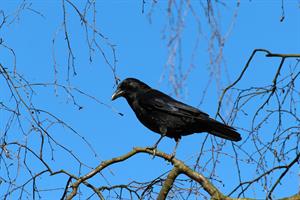
Crow is one of the important characters of the poem
In a nutshell, the first four lines of the poem talk about how a crow settled on a hemlock tree had shaken down some snow dust on the speaker.
From reading the above stanza, it is clear that the poem is set during a winter day. The winter could be seen as a metaphor here, suggesting the speaker's mood. Winter often represents death, sadness, loneliness, or even retrospection in literature. We have colder weather in the winter, occasionally accompanied by snow and frost, no leaves appear on the trees, flowers never blossom, and the amount of daylight during the day is at its smallest. On the other hand, winter is also seen as a season of perseverance. One has to get through the winter to experience the spring or summer. To quote Shelley, "If a winter comes, can spring be far behind". If one is strong enough to endure and persevere through hard times, one can find happiness and peace eventually.
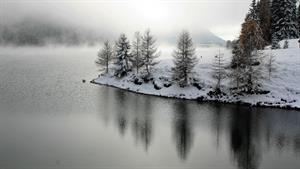
The poem is set during a winter day
Likewise, the words "crow" and "dust" can also be seen as motifs that suggest the theme of death or darkness. Not necessarily evil, but a crow's "appearance in literature and myth is often a symbolic representation of tragedy."* As far as the word "dust" is concerned, it mildly echoes the line from the bible: "for dust you are and to dust you will return.” (Genesis 3:19) In this biblical context, dust means the ashes we turn into once we are dead. According to the Christian doctrine, God created man from the dust of the ground and breathed life into his nostrils, transforming him into a living being.
So, these motifs reveal more than what was said by the poet. They establish the speaker's frame of mind that he was gloomy, and he was probably pondering over darker thoughts such as death.
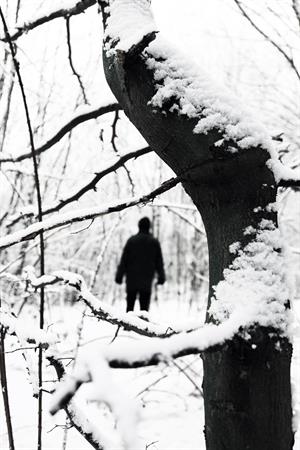
However, the poem takes a positive turn towards the end of the first stanza. The appearance of a "hemlock tree" brings hope; it also encourages the readers to believe that the speaker is coming out of his gloominess. What is crucial here is the speaker's choice of hemlock: a "tree". One should note that there is a plant and a tree in the name of hemlock. The plant is poisonous and harmful, while the tree is edible and has medicinal qualities. Had the hemlock been a plant, the whole poem might have been perceived differently. But Frost (the poet) decided that he should pull his speaker out of gloominess. Hence, he chose the tree with positive qualities as a motif of the poem over the plant with negative ones.
Hemlock trees are large, long-lived conifer trees (conifer trees = the trees whose leaves look like needles). Their antiquity makes them ideal for retrospection and inducing philosophical notions. Having outlived several creatures on the earth, they know better than anyone else how impermanent life is. Life is too short and precious for us to remain sad, worried, and wither away.

Hemlock trees¹
Speaking about their habitat, the tress can be found in cool, wet, and dark forests throughout lower Canada, Midwest, and the East Coast. They are shade tolerant and need humidity, but they do not thrive in dry or hot conditions. Hemlocks can also withstand snow and ice better than other conifers, thanks to their flexible branches and feathery needles, which allow snow to settle and branches to bend and bow without breaking. This offers shelter beneath the surface.
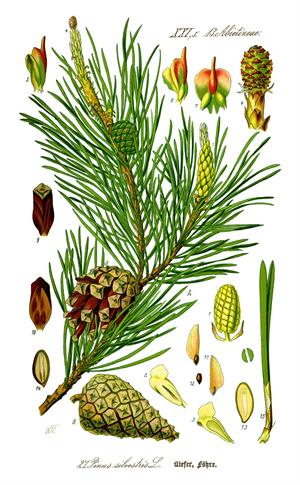
Illustration of needles, cones, and seeds of a pine tree²
Hemlock trees also features prominently in Native American legends. Hemlock is seen as a symbol of warmth, heat, and light. Some legends also talk about how a hemlock tree and a raven had brought light to the world. Interestingly enough, the poem also has a crow on a hemlock tree transforming the narrator's low spirits.
To recollect, let us look at the key points from the stanza:
- The poem takes place during the winter
- There was a crow on a hemlock tree
- It pushed down some snow dust on the speaker
- And more importantly, the incident appears momentous in the speaker's life
In the second stanza, the speaker explains his reaction to the incident from the previous stanza. To recall, we had seen in the previous stanza that a crow had pushed down some snow dust on the speaker. It was also seated on a hemlock tree. As previously noted, it is a trivial incident. However, the speaker finds the moment philosophical and transforming`.
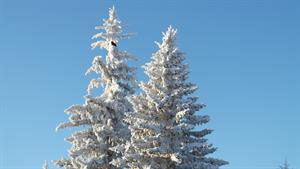
Following the event, the speaker observes that it had "given his heart a change of mood". As seen in the previous stanza, the speaker was going through a bad phase. He was gloomy and was probably thinking about death. Although it is unclear as to why he was gloomy, the speaker declares that his mood had changed for the better. The incident was in no way incidental; instead, it was transformational to the speaker.
One should remember that the speaker was specific that it was "the way" the crow shook down the snow dust that brought the change. Birds often migrate to warmer climates during winter, and crows are no exception. However, not all crows fly away to escape the cold. Some stay back for reasons not understood. They fall into a category known as partial migration. Writing about migratory habits in crows, ZME Science observes that "some stay right where they are, toughing out the frigid days as they best can. Others choose to move to warmer areas, returning only when the cold has faded away."*
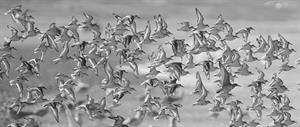
So coming back to the point, it could be the knowledge that a crow was surviving through the cold winter day that made the speaker realise that he could survive through his bad days too. If the bird could live through the cold by shrugging off the snow dust, he could also shake off the unhealthy (and destructive) thoughts and live through the day. It often takes only a moment for a person to do something bad and regretful. Also, it takes only a moment to prevent the person from doing so. Hence, the moment with the crow on the hemlock tree on that winter day proved to be life-changing for the speaker. The crow became an inspiration to stay and survive. In reimagining the myth around crows, the speaker invariably elevates the position of a crow from being a symbol of death and tragedy to that of life and inspiration.
In the third and fourth line of the stanza, the speaker claims that the incident had 'saved some part of a day he had rued'. By changing his mood and outlook on life, he feels that a part of the day he had destroyed has been saved. So here, the concept of "save" is on two levels: literal and metaphorical. As mentioned, a part of his day has been saved by the incident, and that is the literal meaning. In the metaphorical sense, the incident had only just saved a part of his day; it had saved "him".
The idea that "some part" of the day has been saved, in a way, resonates what Benjamin Franklin had once said: "Lost time is never found again".** The speaker realises that time lost is lost forever. He had a bad day, and he had lost a part of the day being broody. Despite having been out of the mental state, he knows that the time he lost by being sad is lost and gone. He also uses the word "rued" to show that he feels remorse, and regrets for having wasted time. Nevertheless, the regret doesn't hold him back further. He doesn't remain gloomy over the fact that he had lost a good part of his day. Instead, he is glad that at least some part of the day has been saved. The usage of the tense in the line "I had rued" explains that he has put all the lamenting behind (in the past) and is moving forward with the time that has been given. He knows that he has lost time. Yes, it is regrettable that he had almost ruined a part of his day, and he wishes that he was out of his gloomy state sooner. But, he is also wise enough to realise the importance of time, and hence, he doesn't intend to relive his mistake.
To recollect, let us look at the key points from the stanza:
- The incident brings a transformation in the speaker
- It changes his mood for the better
- Some part of his regrettable day gets saved
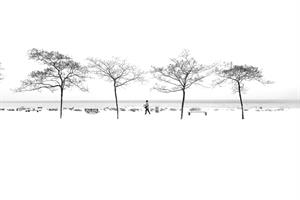
Reference:
https://druidgarden.wordpress.com/2014/01/02/sacred-tree-profile-eastern-hemlock-tsuga-canadensis-magic-mythology-and-qualities/
¹Pic courtesy for 'Hemlock Trees': By Alex O'Neal - View of Rainier, CC BY-SA 2.0, https://commons.wikimedia.org/w/index.php?curid=10052497
²Pic Courtesy for 'Illustration of needles, cones, and seeds of a pine tree': By floranet|]] - Illustration_Pinus_sylvestris0.jpg, Public Domain, https://commons.wikimedia.org/w/index.php?curid=5291505
